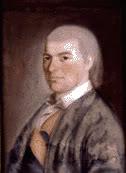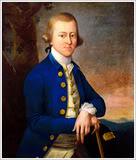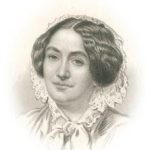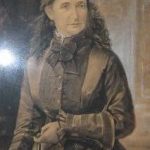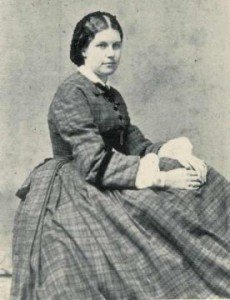Wife of Author Herman Melville
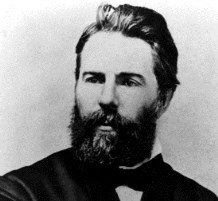
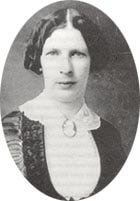 Elizabeth Shaw Melville copied her husband’s works and edited his manuscripts when asked, before and after his death. She was devoted to the author, even when his behavior was erratic.
Elizabeth Shaw Melville copied her husband’s works and edited his manuscripts when asked, before and after his death. She was devoted to the author, even when his behavior was erratic.
Elizabeth Shaw was born June 13, 1822 in Boston, Massachusetts. She was the daughter of Elizabeth Knapp Shaw and Lemuel Shaw, Chief Justice of the Massachusetts Supreme Court and an old friend of the Melville family. It seems that everyone called her Lizzie. Her siblings were all boys, John Oakes, Lemuel and Samuel Savage Shaw.
Herman Melville (1819-1891) was not only a novelist and a poet, he was also an adventurer. In 1841, he signed on the whaler Acushnet, on a three-year whaling voyage. He jumped ship in the Marquesas Islands, and spent four weeks among the natives before boarding other ships for a trip to Hawaii. After months working in various jobs, Melville became restless again and joined the United States Navy, eventually returning to New York filled with marvelous stories.
At the urging of his sisters, Melville began to write down his stories. The result was five books all drawing on his experiences at sea. In the summer of 1845, Melville completed his first novel Typee, which was based on his adventures on the Marquesas Islands. After some difficulty in finding a publisher, Typee was first published in 1846 in London, where it was very popular. A Boston publisher subsequently accepted its sequel, Omoo, sight unseen.
Melville often entertained his admirers by telling stories. As writer and editor Nathaniel Parker Willis wrote, “With his cigar and his Spanish eyes, he talks Typee and Omoo, just as you find the flow of his delightful mind on paper.” These novels gave Melville overnight renown as a writer and adventurer, but they did not generate enough royalties to support him financially.
In 1846 New York City welcomed the young author of Typee, an account of his time among the Typee natives of the Marquesas, as an established member of the American literary scene. He was stalked by autograph hunters, hostesses and photographers. His second book, Omoo: A Narrative of Adventures in the South Seas (1847), an assured success, was published by Harper’s, and he brought out an enlarged edition of Typee.
Marriage and Family
Lemuel Shaw, Chief Justice of the Supreme Court of Massachusetts and a boyhood friend of Melville’s father, had remained loyal to the fatherless Melvilles. Herman dedicated Typee to Shaw, and fell in love with his daughter. Elizabeth Shaw married Herman Melville on August 4, 1847. The couple honeymooned in Canada.
With a $2,000 loan from his father-in-law to contribute toward purchase price, Melville and his brother Allan, also newly married, bought the house at 103 Fourth Avenue for joint occupancy and moved their mother, sisters and brother in with them and their brides. The new Mrs. Herman Melville kept her stepmother in Boston informed of her daily life:
… but sometimes – dear me! we have to go and make calls! and then goodbye to everything else for that day! for upon my word, it takes the whole day – from 1 o’clock till four! and then perhaps we don’t accomplish more than two or three, if unluckily they chance to be in… and all Herman’s and Allan’s friends are so polite, to say nothing of Mrs. M’s old acquaintances, that I am fairly sick of returning calls…. Herman is not fond of parties, and I don’t care anything about them here.
Melville’s next book, Mardi (1849), was a South Seas fantasy. Redburn (1849) was a semi-autobiographical account of Melville’s days in the merchant marine, and White-Jacket (1849), the tale of life on a U.S. man-of-war.
Arrowhead
In 1850, Herman, Lizzie and their baby son Malcolm spent the summer at the Melville farm in Pittsfield, Massachusetts in the Berkshire Mountains. Herman was inspired by the beauty of the region, particularly the view of Mount Greylock from the farmhouse window.
Melville was working on a story about whale fisheries for a friend’s magazine when he was invited to go on a picnic to Monument Mountain, just south of Pittsfield. Oliver Wendell Holmes and Nathaniel Hawthorne, both Berkshire residents, were also invited on the outing. An immediate close friendship developed between Melville and Hawthorne.
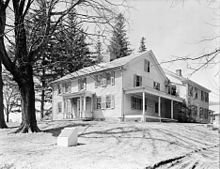 Image: Arrowhead, the Melville home
Image: Arrowhead, the Melville home
Pittsfield, Massachusetts
The impulsive Melville decided to move permanently to the Berkshires in search of a quiet place in which to write. In September 1850 the Melvilles purchased a nearby a farmhouse, which they named Arrowhead, after the native relics discovered while plowing the fields. This would be their home for the next thirteen years, and Melville would write some of his finest works there.
This rambling 1783 farmhouse became home for Herman, Lizzie, Malcolm and three more children, all born at Arrowhead: Stanwix, Bessie and Fanny. Herman’s mother and sisters Augusta, Helen and Fanny all moved to Arrowhead as well. Sister Kate and numerous other friends and relations would make their home there as well at various times. It was a busy, chaotic household.
However, Herman created a refuge from this chaos in his second-floor library. Keeping to a regular writing schedule, he completed four novels, a collection of short stories and 10 magazine pieces, as well as beginning work on a volume of poetry. These works include Moby Dick, Pierre, The Confidence Man, Israel Potter, “The Piazza Tales,” “I and My Chimney,” “Benito Cereno” and “Bartleby the Scrivener.
Melville’s new neighbors, Nathaniel and Sophia Hawthorne recorded their impressions of him in their respective notebooks, Hawthorne noting a “characteristic gravity and reserve of manner,” while his wife declared Melville to be:
… a man with a true warm heart and soul and an intellect – with life to his finger-tips – And I am not sure that he is not a very great man… once in a while his animation gives place to a singularly quiet expression… an indrawn, dim look, but which at the same time makes you feel that he is at that instant taking deepest note of what is before him. It is a strange, lazy glance, but with a power in it quite unique – it… take[s] you into himself…
Moby Dick
During the years on Fourth Avenue in New York City, Melville had written the first chapters of Moby Dick. At first the writing went smoothly. In early May 1850 he wrote to Richard Henry Dana, also a sea author, saying he was already “half way” done.
However, Melville was inspired and encouraged by his new relationship with Hawthorne while he was completing Moby Dick. Over the next several months, Melville’s plan for the book underwent a radical transformation. Though the two men would gradually grow apart, their time as neighbors in 1850 helped shape what is widely considered one of the greatest works of American literature.
Moby Dick, which Melville dedicated to Hawthorne, was finally published in London in October 1851 and a month later in America. His investment of two years’ intensive work in its making had brought a return of some praise, a number of lukewarm reviews, but little money. Lizzie managed the house as best she could, but supper in the household sometimes consisted of tea, toast and little else, meager fare for growing children.
Badly in need of a commercial success, Melville hoped to quickly dash off a pot-boiler that would at least allow him to catch up on the bills. During the winter of 1851–1852 at Pittsfield, he completed the novel Pierre, or The Ambiguities. Pierre’s story sometimes mirrors Melville’s own life. His granddaughter later revealed that family members had worried that readers might misconstrue fiction as fact. Pierre was not well received. One critic called it “utterly unworthy of Mr. Melville’s genius.” In the novel, the character of Pierre said:
Two books are being writ; of which the world shall only see one, and that the bungled one. The larger book, and the infinitely better, is for Pierre’s own private self. That it is, whose unfathomable cravings drink his blood; the other only demands his ink.
When published, Pierre was yet another critical and financial disaster. Only 33 years old, Melville saw his career in ruins. In 1853 a fire at the offices of his New York publishers destroyed most of his books, but he persevered. Israel Potter was published in 1855, but it did not appear that Melville had decided to write down to public taste.
Melville’s family life was punctuated with moments of joy and difficulties. His four children enjoyed life in Pittsfield, but Lizzie had difficulty with her hay fever and frequently took trips back home to Boston. As much as Melville loved the Berkshires, he grew frustrated at the lack of success of his writing career and found his debts mounting.
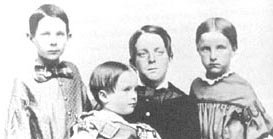 Image: The Melville Children
Image: The Melville Children
Deeply in debt and behind on his mortgage payments, in 1863 Herman traded Arrowhead for his brother Allan’s house at 104 East 26th Street in New York City. Lizzie loathed winters in the country, and Herman needed the stimulation of an active community around him. Inheritances from both sides of the family enabled them to pay off some debts, and they were pleased to return to city life. They lived off Lizzie’s inheritance after the death of her father. Melville continued to visit Arrowhead through the 1880s.
With his great novels written by his early thirties, Melville sank slowly over the next 30 years into depressive oblivion in a yellow brick townhouse on East 26th Street. He gave up novel writing for poetry, but finding publishers was difficult. In 1861, he sought a consular post, but did not receive the appointment. When the Civil War broke out, he volunteered for the Navy, but was again rejected. Harper and Row published Melville’s Civil War poems, Battle Pieces and Aspects of the War (1866), but the public took no notice.
With family pressures to find gainful employment, Melville took a position as a customs inspector on the New York docks in 1866. He held this job for twenty years, working six days a week with only two weeks of vacation a year. The man who had sailed the world and written great American literature now found himself working at a job that paid four dollars a day.
Herman and Lizzie outlived both of their sons. In 1867, their oldest son Malcolm shot himself after a quarrel with his father. It is unclear whether the fatal shooting was intentional or accidental. Their son Stanwix had gone to sea in 1869; he died of tuberculosis in a San Francisco hospital in 1886. As for the Melville daughters, one was a spinster, and the other reportedly did not want to hear her father’s name, regarding him as a beast.
Having written several novels that would later be considered classics, Herman Melville seemed to dry up. His decision to write only poetry did not endear him to the American public. His customs job certainly interfered with is creative time, and there were whispers of alcoholism, insanity and abusing his wife. In a letter to Catherine Gansevoort in 1876, Lizzie wrote:
The fact is, that Herman, poor fellow, is in such a frightfully nervous state, and particularly now with such an added strain on his mind, that I am actually afraid to have any one here for fear he will be upset entirely, and not be able to go on with the printing. He was not willing to have even his own sisters here…. If ever this dreadful incubus of a book [Clarel] (I call it so because it has undermined all our happiness) gets off Herman’s shoulders I do hope he may be in better mental health – but at present I have reason to feel the gravest concern and anxiety about it – to put it in mild phrase….
Melville’s uncle funded the publication of this 16,000-line epic poem, Clarel (1876). Critics bashed it and readers ignored it, and publishers were forced to burn many unsold copies.
A small legacy from Lizzie’s relatives finally enabled Melville to retire from the Customs House in 1886. That year Herman presented Lizzie with a book of poetry entitled Weeds and Wildings, Chiefly, with a Rose or Two. Many of the poems were about their happy days at Arrowhead.
Melville self-published five volumes of poetry before his death. His second collection of verse, John Marr, and Other Sailors; With Some Sea-Pieces, appeared in 1888.
In December 1889 he responded to a rare request for details of his life and work with a gentle refusal:
After twenty years nearly, as an outdoor Custom House officer, I have latterly come into possession of unobstructed leisure, but only just as, in the course of nature, my vigor sensibly declines. What little is left of it I husband for certain matters as yet incomplete, and which indeed may never be completed.
After retiring from the customs service, he returned to fiction to write the novella, Billy Budd. Begun in early 1886, Herman Melville worked on the project until his death of a heart attack at 72 on September 28, 1891. It would remain unknown to the world until the Melville Revival rediscovered him in the 1920s. Billy Budd, whose pages Lizzie had stored in a bread box, was published in 1924.
Elizabeth Shaw Melville died July 31, 1906 in New York City.
SOURCES
Herman Melville
Wikipedia: Herman Melville
Herman Melville and Arrowhead
Poets.org: Herman Melville’s Downtown New York City
New York Observer: Melville Mystery Cannot Be Stifled By New Biography
